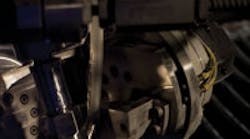1. When cutting under 0.100-inch thick material, little is gained by using medium (50 hp) or large (60 to 80 hp) cutting heads. Use a small parameter combination (25 hp) and consider multiple heads to increase production if needed.
2. Avoid cutting through air gaps greater than 0.020 inches. The jet tends to open up in the gap and cut the lower layer roughly. When stack cutting, keep the sheets together.
3. Smaller abrasive grains 120 mesh or smaller will produce a slightly slower, but slightly smoother surface as compared with 80 or 50 mesh.
4. Some users make the mistake of trying to reduce operating cost by minimizing the abrasive flow rate. Even though abrasive is two-thirds of the abrasive waterjet operating cost, you must produce parts quickly to consume your overhead, including labor, facilities and lease payments. Cut as fast as possible, using all available horsepower and the peak abrasive flow rate.
5. If you intend to pierce composites, glass and stone on a regular basis, ensure the system has the ability to have the water pressure lowered and raised by the controller. Also, you should investigate vacuum assist or other techniques to improve probability of successfully piercing these brittle or laminated materials.
7. Most machines do not employ material handling automation, such as shuttles. Only when material handling constitutes a significant portion of part production cost should automation be considered.
8. Ordinary tap water is used to feed the waterjet systems. About 90% of all waterjet and abrasive waterjet users require only water softening prior to sending that water through the pump's inlet water filters and then to the intensifier.
9. Cutting underwater reduces surface frosting or "hazing" found on the top edge of an abrasive waterjet cut, and also greatly reduces jet noise and workplace mess. The only negative is that operators cannot see the jet clearly during cutting. If the operator objects to the underwater cutting, consider electronic performance monitors, which will detect deviation from peak cutting performance and stop the system prior to part damage.
10. If you plan on using different abrasive mesh sizes for different jobs, consider adding a small 100 pound or larger 500- to 2,000-pound bulk transfer.
11. Break-out tabs can prove effective for cutting of materials under 0.3 inches thick. The harder the material, the smaller the breakout tab should be.
See Also



